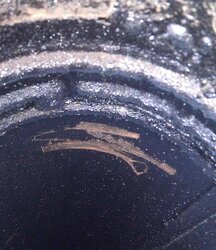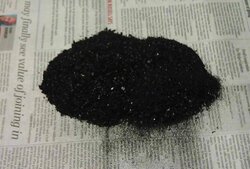So I swept the flue today and got over a cup of black shiny creo chips. This is from just 3 weeks of part-time burning of 3-year C/S/S red oak and other wood (ash, maple, cherry) C/S/S over 1 year. In prior years, I blamed the wood not being well enough seasoned. The flue is 25' vertical single-wall stainless 6-inch rigid pipe surrounded by thermix in a masonry chimney. With the fuel seemingly seasoned well enough, our burning habits could be at fault. The picture of the liner inner surface shows where I scraped away some creo with a screwdriver before poly-brushing it. At least the creosote was brittle and easier to remove than before. We burn weekends and evenings (overnight) but not weekdays. I've stepped outside a thousand times and viewed the chimney to figure out how to tweak the burn for heat waves but no smoke. Top-down startup fires get a little sizzling but no bubbling. Just can't figure it out.
Still getting creosote in flue
- Thread starter Gark
- Start date
-
Active since 1995, Hearth.com is THE place on the internet for free information and advice about wood stoves, pellet stoves and other energy saving equipment.
We strive to provide opinions, articles, discussions and history related to Hearth Products and in a more general sense, energy issues.
We promote the EFFICIENT, RESPONSIBLE, CLEAN and SAFE use of all fuels, whether renewable or fossil.
You are using an out of date browser. It may not display this or other websites correctly.
You should upgrade or use an alternative browser.
You should upgrade or use an alternative browser.
- Status
- Not open for further replies.
I would like to know flue temps but your setup doesn't really allow for that. What type of stove top temps are you running at? It doesn't look like your doing anything horribly wrong, maybe just a tweak or two. At first blush I would say you are running cool stack temps and need to heat it up a bit more.
wjb111
Member
I'm not an expert by any means but just my .02 :-S My guess is since your having your burns on just evenings & weekends the more frequent start ups & cool downs would be the culprit.
It sounds like your wood choice is ideal so I wouldn't point at that.
Good Luck & Good Burning...
It sounds like your wood choice is ideal so I wouldn't point at that.

Good Luck & Good Burning...
JotulOwner
Feeling the Heat
Gark said:Top-down startup fires get a little sizzling but no bubbling. Just can't figure it out.
Whenever I hear sizzling, I am thinking my wood isn't as dry as it should be. Bubbling would be green wood in my opinion (JMO).
dry wood does not sizzle or bubble. One slight mod to that statement, if the wood has been rain soaked then you would get sizzel even if properly seasoned to a moisture content of less than 20%. In either case s or b is going to cause cooling of the stack temp resulting in the black death on the walls of the flue. By the way that s or b is cooling off your cat also and likely that is the cause of your problem. just my .002 cents worth
The only wood here that hisses is the skinny kindling used for starter fires. The fat splits used for real burns never sizzle or bubble, they light up quickly and outgas well. Flue temp as measured on the singlewall steel black stovepipe three inches from the stove collar is kept at (350 f. by magnetic bimetal thermo = 450 f. by IR thermo). Don't have a probe in the stovepipe, but that 350 f. is the magic point where only heat waves come out the stack. Never occured to me that all the cold startups might cause the creo, but it makes sense - during start, it's really no diff. than a pre-EPA airtight.
O
oldspark
Guest
I do cold starts a lot, especially this warm winter and in the fall and spring and no problems with creosote, (not with the old chimney and Nashua either) but I do burn my flue hot on start ups (sometimes I have no choice in the matter) which can be 600 (surface single wall pipe), are you burning the flue hot for periods of time when you burn?
So far, I back off the intake air during cold starts to keep the stovepipe surface thermo from going above 500 or so because the magnetic thermo shows 450 and above to be "too hot". During reload (damper-open charring burn) it may get up to 550 but not for long because I get nervous and reduce the air. The IR thermo measured there always reads 100 degrees more than the magnetic device, so I guess it does hit 600 but not for long. Is it OK to let it sit at 600 surface for awhile?oldspark said:I do cold starts a lot, especially this warm winter and in the fall and spring and no problems with creosote, (not with the old chimney and Nashua either) but I do burn my flue hot on start ups (sometimes I have no choice in the matter) which can be 600 (surface single wall pipe), are you burning the flue hot for periods of time when you burn?
O
oldspark
Guest
Yes its fine as long as you just had the chimney cleaned and you keep up the practice, just a few feet up the pipe that temp tapers fairly quickly so it may be only 400 to 450 just a few feet up the pipe. You only have a chimney fire when you have creosote (duh) so prevention is the key. Any thing above 450 is considered wasteing heat so just for shorts bursts you will be fine. I like to see at least 1/2 hour to 1 hour a day at a higher temp flue, 500 to 600.
Measuring those temps at only 3 inches above the collar might be misleading you. My sweep (a long time certified, local and personal friend) states that the optimum distance to measure flue temp is 24" above the stove/collar. I am still betting on you running the flue temp at the lower recommended level. Nothing too bad, but just past the brink of smoke. And that is allowing some junk to accumulate at the top (read - cooler) level of your stack. Just my guess at this point.
O
oldspark
Guest
Yep I forgot where he is reading the temp, 600 temp reading it there will not hurt one thing and probably help with the creosote, let it run there for a hour a day and see what the results are.
I hate to get in on this because you guys are on to the right track. IF there is any difference in wood types I'm not sure? I burn hot, more than most people do. I would guess Gark is not quite hot enough for long enough. The soot can be in the pipe as long as it is not big and fuzzy or thick, thats when you are at high risk to meet the dog who lives in the pipe "WOOF". You don't have to go much hotter but a bit more would help, yes you will go through a bit more wood but what are you after.
The replies make good sense. Thank you. Indeed, the creosote is all found in the top 6' of flue where it would be coolest. Our stove cannot maintain more than 400 f. flue temp while running well in cat mode because it dissipates alot of heat before the exhaust gets out of the collar. It has had 830 f. (Measured on back shoulders) overburn a couple times and the flue thermo was 400f. I'll make hot open-damper fires that burn awhile and watch for a cleaner pipe.
It sounds like you have made a lot of progress and are close to having this licked. I would shoot for getting the wood to the point of no sizzle. Maybe it just needs a week or so indoors to dry out that last bit of moisture? Is it stored fully covered, top only covered or no cover at all? Is the chimney interior or exterior? How is the stove connected to the chimney, single or double-wall?
Question relating to this...kinda...I got a soot eater, and obviously I needed the 6 extra feet cause I am not getting to the very top....I've been real careful to sweep every few weeks being a newbie... Exactly how bad is it that I am lacking in those 6 feet?
The last 6 ft can be where a majority of creosote accumulates. If you are sweeping top down this would be less of an issue. But with bottom up sweeping, this can lead to a false sense of comfort and future problems. Best to get an extension, especially if the wood is less than ideally seasoned.
BeGreen said:The last 6 ft can be where a majority of creosote accumulates. If you are sweeping top down this would be less of an issue. But with bottom up sweeping, this can lead to a false sense of comfort and future problems. Best to get an extension, especially if the wood is less than ideally seasoned.
Figured...Just had to read it for my own good....
The firewood does not sizzle as it's C/S/S outdoors in single rows in open windy field, 3 years for the oak. Only the kindling sizzles a little sometimes. Firewood is stored after seasoning in an unheated space totally surrounded by cement, no weather gets to it. The 6" chimney pipe (singlewall) exits the stove horizontally for 2 feet, through the thimble and it T's into the rigid 6" stainless singlewall liner which is 25' tall vertical. The liner is inside an internal masonry chimney (clay lined) and thermix has been poured between the liner and masonry chimney. I am trying to measure flue temp with a simple magnetic thermo stuck on top of the stovepipe 3 inches out from the collar. I also confirm the pipe temp with an IR gun - it usually reads about a hundred above what the magnetic thermo says. IAW the responses so far, I am leaving the damper open much longer at hotter temps before engaging the cat. I will be going after hotter blurns now instead of fuel-conservation burns and we'll see how the creosote is reduced from that.
- Status
- Not open for further replies.
Similar threads
- Replies
- 22
- Views
- 2K
- Replies
- 0
- Views
- 2K



